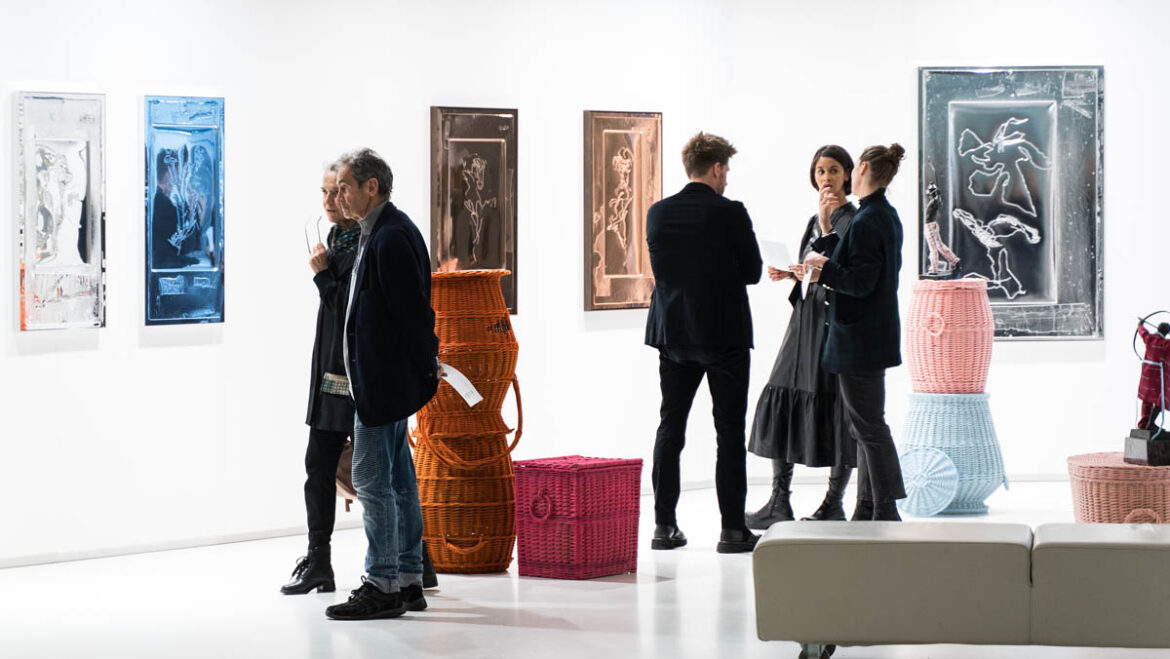
Camille, the theatre setting plays a key role in your section “Spectāre” at STAGE Bregenz 2025. How do you address theatricality? Who are the artists you are working with?
I was surprised by the venue when I visited STAGE Bregenz last year. I found it amazing to stage a fair in an opera house. Director Renger van den Heuvel’s invitation to curate a section at the fair came right after my visit to Bregenz. Seeing the space firsthand was invaluable. Immediately, I knew I wanted to work with the setting and its performative dimensions, its infrastructure, and its possibilities—to engage with them rather than resisting them. Besides, collaborating with a team of technical experts and having access to the Festspielhaus‘s equipment is a dream for exhibition-making.
In contemporary art, we often praise the white cube for its supposed neutrality, granting more ‘autonomy’ to the artwork—though, truthfully, it is never entirely neutral. In the 60s, American art critic Michael Fried famously argued that theatricality in art posed problems to art’s authenticity. He was against any form of engagement with the art, which today feels a bit outdated. After all, so much of the art’s rhetoric borrows from theatre—terms like showcase, spotlight, perform, engage, stage, and play a role. Art is not merely passive or contemplative—it is active.

So, what does it mean for a fair to transition from the standard white cube to a black box? The black box has its own set of codes and conventions—it conceals the environment and the audience to heighten the experience and direct the gaze. I’m interested in those codes because they are tightly connected to the concept of ‘theatricality’—a term inherent to the physical context of the theatre and the spectacle but one that also overcomes it, emerging whenever something is perceived as staged.
I named the section ‚Spectāre’—from the Latin spec- meaning ‚to observe, to look at’—to emphasize the act of looking. It conveys an idea of engagement or action from the person who is looking. The section’s layout encourages a wandering through space, but at its core, it seeks to activate a different perception and reception of the works—making us aware of our gaze, of the observed and observer, and the performativity of it all: how bodies move, act, and shape the space.
For my section, I am thrilled to have invited gallery CASTIGLIONI (Milan, Italy) with Bianca Millan; Damien & The Love Guru (Zurich, Switzerland, and Brussels, Belgium), presenting Jim C. Nedd and Agatha Wara; City Galerie (Vienna, Austria) with Fabienne Audéoud and Billy Coulthurst; Gallery Parliament (Paris, France) showcasing works by Alfredo Aceto, Achraf Touloub, and Guillaume Valenti; Rolando Anselmi (Rome, Italy) exhibiting Ulrich Erben and Johannes Wald; as well as Zeller van Almsick (Vienna, Austria) with Jonny Niesche and Laura Schawelka; Xippas (Geneva, Switzerland, and Paris, France) featuring Thomas Liu Le Lann; and Windhager von Kaenel (Zug, Switzerland) showing Gina Proenza.
I selected these artists for their interests in ‘performativity’, which they explore through words, images, gestures, or sound. I’m also intrigued by the intersection of live or time-based practices and the art market. So, it felt essential to include live interventions in the section.

Tell us more about the artists‘ works and the program in your section.
In terms of programming, I’m thrilled that artists Agatha Wara and Jim C. Nedd are both incorporating live acts into their presentation at the fair, activating the space through voice, sound, and music composition. There will also be a performance by Fabienne Audéoud, whose practice moves between performance, text, painting, and sculpture. Speaking of text, Gina Proenza’s work in the section aligns with her ongoing exploration of language and its repressive or historical aspects. Billy Coulthurst will show paintings, while Thomas Liu Le Lann will present a scenic installation made of glass and soft sculptures. His so-called “soft heroes” oscillate between intimate representations of friends and popular cartoons. The notion of looking and illusion will be tackled by artist Laura Schawelka, whose work often finds grounds in the effective and affective power of images. On the other side of the spectrum of works, there will be abstract mirror works by Jonny Niesche, evoking makeup palettes, as well as works by minimalist artist Ulrich Erben, born in the 40s and known for his spectacularly large paintings. Erben’s work will be in dialogue with that of Johannes Wald, who investigates the perpetual quest and vulnerability of being an artist. Their gallery, Rolando Anselmi, said that the two artists share great mutual respect, so I’m happy to have them shown together. Last but not least, there will be a site-specific sound installation by Bianca Millan…
Camille, how did you and Bianca meet, and what led to your decision to collaborate?
Bianca also attended STAGE Bregenz as a visitor last year. At the time, she was recording with an app her steps from Bregenz to her residency at the foundry Sitterwerk in St. Gallen. It was such a nice coincidence—when I approached her gallery CASTIGLIONI for the section, I had no idea she had already recorded preliminary data in Bregenz the year before. Now, those recordings will be reintegrated into a new installation at the fair, somehow bringing it full circle. I’m excited about Bianca’s approach to time and space, as well as the engaging nature of her work. Indeed, spectators are accommodated into a sonic setting that she creates, with an interactive element that tracks live information from the audience entering the space. It is a perfect fit for the section.


Bianca, could you share your thoughts from when you recorded last year? Did you have any projects in mind at the time? Why did you start recording this material in the first place?
When I went to Bregenz last year, it was around the time when I changed the technology with which I was working. For many years, I used a GPS tracker to record data on my movements, displacements, and traces—mapping the trajectories I created both in the digital space and life.
In 2024, instead, I started using an app which transforms your steps into virtual coins, which is the kind of data I was recording during my stay in Bregenz. This app developed my interest in the concept of currency, and I started investigating metals, their values, and their characteristics. Since one of the main languages I use in my work is sound, I focused on the sonic properties of metal while I kept collecting data from this app throughout my research, although I had no idea that I would finally present this project in Bregenz one year later. In my practice, there isn’t a real distinction between moments when I am collecting data or working on a project, or when I am not; it is a rather blurred line. When Camille contacted CASTIGLIONI to collaborate on this edition, I found a deep connection with her approach to the expanded stage, a dimension where one can recreate reality and unpack the different narratives and layers that constitute it; but once you’re re-enacting them, you lose the perception of who’s the audience and who is the actor, and a temporary community is created.


In addition to presenting this long-term project, I’d like to ask: Will you still be tracking what happens in the room during the art fair?
Yes, we will present a listening device where people are going to be invited to sit and take a moment, or even lie down and listen to a composition resulting from their presence and interaction with the space and the artworks. That’s when the audience is no longer just a spectator but a composer at the same time. For me, there is no limit to what a stage is because of the constant tracking of our lives through our smartphones and electronic devices, so in a way we are constantly performing for this complex system—once you’re aware that you’re on a “stage,” then how do you want to perform for the others, and how do you pay attention to both the space and the role of the others?

Funny enough, in our introductory talk, we all realized we had read the same article in the morning about how uninteresting art has become today. Do you think the art fair aims to find new rituals, to reinvent itself?
Camille: From a curatorial perspective, I find it compelling to question the presentation format of art fairs, especially at a time when the art market seems to tire, and people need strong reasons to come. Fairs are places to make connections where artists, galleries, and institutions converge. Beyond sales, they offer opportunities for dialogue and discovering. Luckily, the Vorarlberg region has a dynamic cultural scene with many interesting institutions. STAGE Bregenz is aware of it and actively fosters exchange by inviting a group of international curators each year to visit the region. This openness also extends to the fair’s curated sections, allowing room to experiment and include practices beyond object-based work. Plus, the fair is still young, which means it has the freedom to define itself beyond any sort of traditional structures, unbound to historical or reputational constraints. In this context, I would say that Bianca’s installation resonates deeply. Her work not only activates space but also cultivates a sense of shared experience. It aligns with the idea of forming temporary communities and testing new rituals—rethinking how we inhabit fairs, how we move through them, and how we engage with art in such settings.
Bianca: For example, what we see happening in fashion in the last years is that everything goes towards the experience, the community building. So I’m surprised that it’s taking so long for the art world to kind of catch up with this.
STAGE Bregenz 2025
20–23 March 2025, Festspielhaus Bregenz
Opening: 20 March 2025
Preview: from 14:00 (with invitation)
Public Opening: 17:00–20:00
21 March: 12:00–19:00
22 March: 11:00–19:00
23 March: 10:00–18:00
Tickets: www.visitbregenz.com
Information and list of galleries: www.stage-bregenz.art
STAGE Bregenz, the 2025 fair, will include two curated sections. The curators will select the galleries for these sections. This year’s curators are Camille Regli and Hana Ostan-Ožbolt-Haas. At STAGE BREGENZ, there is a good balance between commercial and experience-based work. What makes this fair unique—and what I hope my work highlights, as Camille mentioned—is the coexistence of a commercial approach and a strong connection to the institutions shaping this special region and its networks.
Camille Regli is an independent curator based in Zurich and Biel/Bienne, Switzerland. She’s the co-founder and co-director of KRONE COURONNE, a centre for contemporary art in Biel/Bienne, Switzerland, and a member of the curatorial group Collectif Détente. She has collaborated with institutions such as the Kunsthaus Biel/Centre d’art Bienne, Fondazione Sandretto Re Rebaudengo, the Swiss Pavilion at the Venice Biennale, and the Centre d’art contemporain Genève. In her curatorial practice, Camille is interested in the transformative power of art, particularly through the notions of performativity, and the use of speculative fiction and feminist readings as a means of emancipating and critically addressing our relation to the world. www.instagram.com/camrgli/
Bianca Millan (born 1992) is an artist based in Paris and Milan. She works across media, and her practice moves between installation, painting, performance, and sound art. Her language is influenced by cartography, scientific exploration, meteorology, astronomy, and transport to investigate movement and traces, hidden messages, stratified, and unexpected connections like forgotten alphabets engaging in a game of unclear or forgotten rules, that the artist restores and forges. In her work, a reenactment of memory, everyday stratified landscapes, and interconnected traces are often developed as sound installations and music. In 2019, Bianca started the Blue Traces project with musician and composer Giovanni Di Giandomenico. The project investigates what it means to be both a private physical individual and a global digital subject mapped by new technologies. www.instagram.com/enaramillan/




